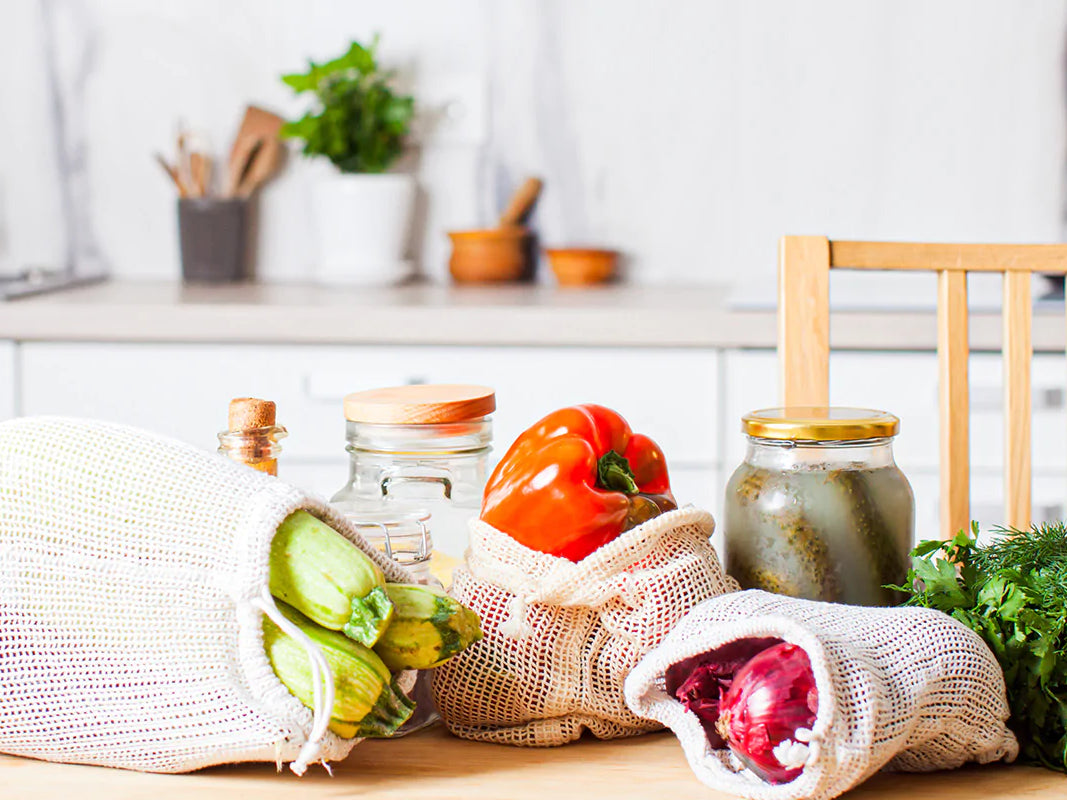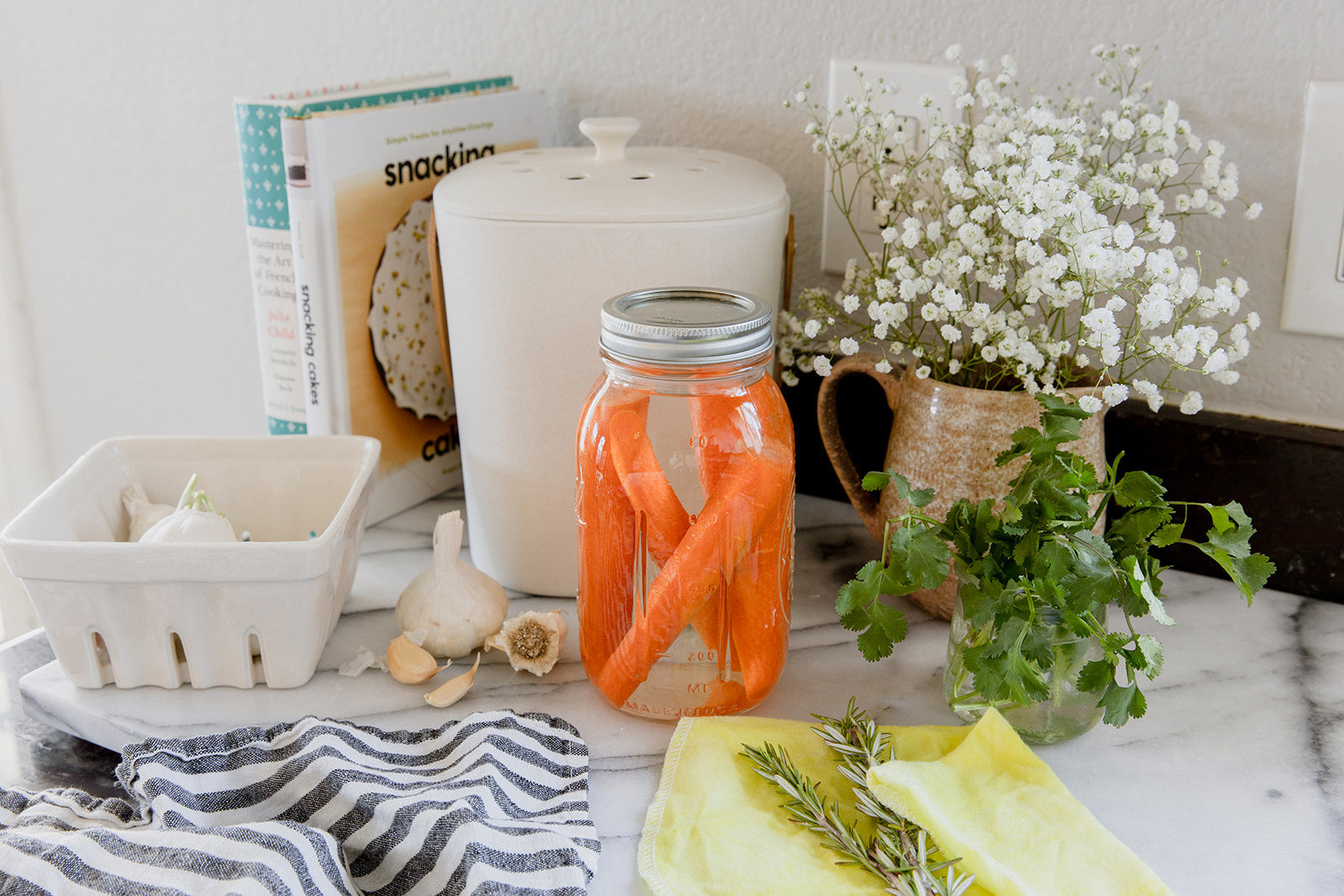3 Easy Ways To Reduce Your Food Waste At Home - And How To Actually Do Them

Doing these three things can help you reduce your food waste at home and turn those food scraps into more food and less waste.
Estimated Read Time: 7 Minutes
In a perfect world, everyone would have access to all the food they needed and the ability to compost the scraps. Since we don’t live in a perfect world, We can try to reduce our impact on the planet.
One way we can reduce our impact is by composting, and if you haven’t read our blog on composting at home, we’re biased but we recommend you check it out.
If you can’t compost or you’re ready to do more, try working to reduce your food waste!

Below are 3 ideas on how to reduce your food waste at home and how to actually go about doing them.
Reduce Food Waste At Home By Using Scraps To Make Something Else

- Save vegetable peels/skins to make broth. Recipe here.
- Freeze herbs to use later. Chop the herbs, place in an ice cube tray, cover with water (or oil) and freeze. To use, place a cube in a pan/microwave and melt.
- Steep the Strawberry tops in vinegar and make a Strawberry vinaigrette. Recipe here.
- Make a jam with berries you don’t get to eat. Recipe here.
- Freeze fruit/veggies that are about to go bad to use for later in smoothies or other food.
- Save citrus peels in a freezer (reusable) baggie. Add them to a DIY cleaning solution, marinades, or syrups.
- Apple peels can be made into a sweet tea + 6 other uses for apple peels.
- Add stale bread to a food processor to make croutons! Store in an airtight container.
- Add the end of a bread loaf to brown sugar to keep it soft.
- Don’t feed bread to the birds! It offers no nutrients and makes them falsely feel full. Instead, save the animal fat from cooking and make a suet for birds. It helps provide them with energy and calories.
- Eggshells have many uses. They can be ground into a powder (after washing) and used as a non-abrasive scrub, they make a great fertilizer for your plants.
- Coffee grounds can be added to soil as a fertilizer, they can be made into a DIY body scrub, they can act as a natural de-icer if you live in a snowy area, and more!
- Pickle or saute vegetable stems for later or finely chop and add to a salad for crunch (Cauliflower, Kale, Broccoli, Chard). See below on how to store them.

Photo by Tim Umphreys on Unsplash
It is expected that you go now and do every single one of these things.
OBVIOUSLY not, but finding just one or two ways to reuse your food scraps can have an impact on how much goes to the landfill! Once you're comfortable with doing that, try a few more.
Reduce Food Waste By Storing Produce Correctly & Making It Last Longer

Tea towels and flour sack towels can be used in place of paper towels. If you need to use paper towels, opt for unbleached ones that can be composted or those made from recycled paper that are produced with less water.
Lettuce/Spinach
Wash greens in a colander, remove any wilted/brown bits, dry well with a towel, and place into an airtight container. If you use plastic baggies, try to wash and reuse as much as possible. Stasher bags are a good alternative.
Avocado
To save an under ripe Avocado. Storing it in the fridge significantly slows down the ripening time. Take it out a day before you need it.
To make an Avocado ripen faster, put it in a paper bag with another piece of fruit — apple, banana, etc. The gasses help the fruit ripen faster.
To store a partially eaten Avocado. Leave the seed in and squeeze lemon juice on the exposed half. Alternatively, tightly wrap with a reusable food wrap!
Carrots/Celery
Store your carrots & celery in water (separately), it’s that easy! Make sure they’re completely covered in water and change water every few days.
Berries
This goes for any kind of berry — put them directly into an airtight container (unwashed). Add a towel to help absorb the moisture and store in fridge. Wash them before eating!
TIP: If you don’t get to them in time and you see them start to wilt, wash and freeze them to add into smoothies or jams later!
Onions & Garlic
Onions & Garlic should be stored in an open, breathable container and can be stored together. Try storing in paper sandwich bags. Punch holes in the bag, put onions and garlic in and seal with a paperclip. Store in a cool, dry place. Storing onions in the fridge actually makes them go softer faster. Instructions here.
Potatoes
Store potatoes in a breathable container in a dark, cool place like the pantry — away from onions and garlic. They can be in a paper bag, a basket, etc. but make sure they’re ventilated, and away from light.
Bananas
Keep bananas away from other produce — they can speed up the ripening process for the others. Wrap the stems of bananas in foil either individually or together to slow down the ripening.
TIP: If you don’t get to them in time, peel and freeze them to use in a smoothie or something else later!
Herbs
Cilantro & Parsley can be stored in a glass jar with the stems in 1 inch of water. If you have any plastic produce bags lying around, put one over the top to cover the leaves. Change the water every few days.
Other herbs can be wrapped in a damp towel (or paper towel) and stored in an airtight container in the fridge.
Cheese
Wrap your cheese in parchment paper to prevent mold growth. Tie with a spare rubber band or twine and reuse the parchment for the next block.
Ginger
Have a recipe that calls for ginger but you only need a bit? Freeze it! You can grate it frozen and keep the root for several months.
Reduce Food Waste By Planning Your Meals

You’ve heard it time and again, planning out your meals can help you buy less and stick to only what you need.
Creating a meal plan can look however you want it to and be whatever you need to make your life easier. If you can’t eat the same thing 7 days in a row and make everything in one day, you can still make a meal plan!
It can be hard to know what you and your family are going to want in a week, so do your best and freeze what you can. Keep it frozen until another night where you don’t have time to cook (or a late night snack).
1. How Will You Keep Track?
Where are you going to keep your ‘menu’? A physical list, a calendar, an app?
2. Choose How Many Days You Want To Plan For
Setting a menu for a specific number of days knowing a full 7 probably won’t happen can also help you reduce your food waste! For 2 people in a household, try starting with 3-4 meals/week and see how it goes.
3. Find Your Recipes
Having a dedicated place to look for recipes helps save you time. Pinterest Boards and emailing lists are great places to start. Save things throughout your week and when you’re ready to plan you know where to go.
4. Make. A. List.
Arguably the most important aspect of meal planning. Write down what you need for each recipe (and how much). Having a list to stick to keeps your mind focused — bonus points for checking things off — and helps you feel accomplished (which you definitely should feel).
Other Tips To Reduce Your Food Waste From The ZeroWasteStore Team

Photo by Priscilla Du Preez on Unsplash
- Don’t go to the store hungry
- Give yourself a budget
- Don’t do it all at one time. If you need to break it up into a couple smaller trips (because of financials or stress, do it!)
- Shop local — Farmers Markets and local options usually come with less packaging, they cut down the distance your food neels to travel, and help you only buy what you need.
- Always take your reusable grocery and produce bags with you!


Comments (0)